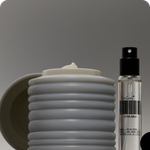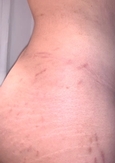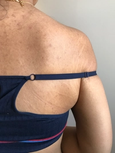Why are stretch marks different colors?
Stretch marks show up in an array of colors. It’s all a cocktail of chance, skin tone, and genetics. Pink, red (called striae rubra), purple, or brown lines are early or relatively new stretch marks, while white marks (striae albae) are those that have been around a while and faded over time.
“Some people get really red stretch marks in the beginning, or even purple,” explains Dr. Shirley Chi, a board-certified dermatologist at the Center for Advanced Dermatology in Arcadia, CA. “And that might be more apparent if you have fairer skin.” A darker stretch mark doesn’t mean it’s more severe.
Certain darker stretch marks can be treated with lightening creams (the same way you’d treat other hyperpigmented skin conditions, like acne scars). “Some men, for instance, will work out and start getting stretch marks that immediately turn brown,” says Dr. Chi, “so I treat them for discoloration with either a hydroquinone or a non-hydroquinone based lightening cream, and then treat the stretch marks with Retin-A and lasers.” Treating stretch marks can be multi-faceted, with topical creams that target the color of the mark and lasers that spark collagen production to tighten the skin.
Get Updates
There’s more to come.
Sign up to receive periodical updates on Mass Index, and to be the first to know when Soft Services launches new products. (If we don’t have any updates, we won’t email you.)
Stretch Marks
Stretch marks are long, jagged streaks where the skin has slightly torn.
Also Called
Striae distensae, striae gravidarum, striae rubra, striae albae
Frequently Found On
Upper arms, breasts, butt, abdomen, hips, thighs
Related Concerns
Learn More: Stretch Marks

























